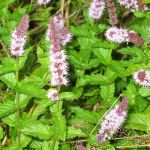| Common Name: |
Garden Mint |
| Other Names: |
Lamb Mint, Spearmint |
| Botanical Name: |
Mentha spicata syn. M. crispa, M. viridis. |
| Genus: |
Mentha |
| Family: |
Lamiaceae |
| Cultivation: |
Rich, moist soil in sun or partial shade. Mentha aquatica thrives in wet soil and M. arvensis tolerates dry conditions. Mentha pulegium prefers damn, sandy, acid soil; M. requienii needs moist shady conditions. Foliage may damaged by mildew and rust, though M. x villosa var. alopecuroides is resistant to rust. Most mints are invasive and are best grown in confined space. Mentha pulegium is a protected species in parts of Europe, and subject to statuatory control as a weed in some countries, notably in parts of Australia. |
| Propagation: |
By seed sown in spring (M. pulegium, M. requienii, M. satureioides only); by division in spring or autumn; by tip cuttings during the growing season, placed in moist soil mix or water (not M. requienii). Mentha requienii usually self sown self-sows. |
| Harvest: |
Whole plants are cut as flowering begins, and leaves are cut during the growing season, and used fresh or dried for use in concentrated waters, infusions, liquid extracts, powders, spirits, or oil distillation. Mentha arvensis is mainly decocted or powdered in Chinese remedies. |
| Height: |
30cm-1m (12-36in) |
| Width: |
Indefinite |
| Variations: |
Var. crispa syn. 'Crispa' (Curly spearmint)
Has strongly crinkled leaves with a less pronounced spearmint flavor. |
Moroccan
Has close-set leaves with a fine spearmint flavor. |
Tashkent
Is vigorous, with a good spearmint flavor |
|
| Hardiness: |
Z4-9 |
| Parts Used: |
Whole plant, Leaves, oil, petals, flowers. |
| Chemical Constituents: |
Carvone
Resin
Volatile Oils
|
| Properties: |
An aromatic, stimulant herb that improves digestion and relieves spasms. Oil is less pungent than peppermint oil and is non-irritant. |
| Known Effects: |
Stimulates muscular action of gastrointestinal tract
Helps treat nausea
Miscellaneous Information:
Spearmint is used as a flavoring agent in many foods.
|
| Possible Additional Effects: |
May help expel gas from intestinal tract
May soothe sore throats
May treat sinus congestion
|
| Medicinal Uses: |
Internally for colic, gas, indigestion, hiccups, and feverish childhood illnesses. Combined with Ballota nigra (See, Black Horehound) for upper respiratory tract infections in children. |
| Warnings and Precautions: |
Don't take if you:
Are pregnant, think you may be pregnant, or plan pregnancy in the near future
Have any chronic disease of the gastrointestinal tract, such as stomach or duodenal ulcers, reflux esophagitis, ulcerative colitis, spastic colitis, diverticulosis, or diverticulitis
Consult your doctor if you:
Take this herb for any medical problem that doesn't improve in 2 weeks (There may be safer more effective treatments.)
Take any medicinal drugs or herbs including aspirin, laxatives, cold and cough remedies, antacids, vitamins, minerals, amino acids, supplements, other prescription or non-prescription drugs
Want to use for morning sickness
Pregnancy:
Don't use unless prescribed by your doctor.
Breastfeeding:
Don't use unless prescribed by your doctor.
Infants and Children:
Treating infants and children under 2 with any herbal preparation is hazardous.
Others:
None are expected if you are beyond childhood, under 45, not pregnant, basically healthy, take it only for a short time and do not exceed manufacturer's recommended dose.
Storage:
Store in cool, dry area away from direct light, but don't freeze.
Store safely out of reach of children.
Don't store in bathroom medicine cabinet. Heat and moisture may change the action of the herb.
Safe Dosage:
Consult your doctor for the appropriate dose for your condition.
|
| Adverse Reactions, Side Effects, or Overdose Symptoms: |
| Signs and Symptoms |
What to Do |
|
| Convulsions and Coma |
Seek emergency treatment |
| Diarrhea |
Discontinue. Call doctor immediately. |
| Nausea or Vomiting |
Discontinue. Call doctor immediately. |
|
| Culinary Uses: |
Leaves are widley used for flavoring, with peas and potatoes; for making mint sauce and jelly to accompany lamb (UK); and as an ingredient of herb teas and iced drinks, appetizers such as tzatziki (E Europe), and salads, such as tabbouleh (Middle East); also for garnishing (notably halloumi cheese in Greece). |
| Economic Uses: |
Oil is used in commercial food flavoring (notably in chewing gum), oral hygeine preparations, and herb tea blends. |
| Bibliography: |
Encylopedia of Herbs by Deni Brown Copyright ©: 1995, 2001 Dorling Kindersley Limited pp.275-277
Vitamins, Herbs, Minerals, & Supplements The Complete Guide by H. Winter Griffith, MD Copyright©1998 Fisher Books pp. 442-443 |
